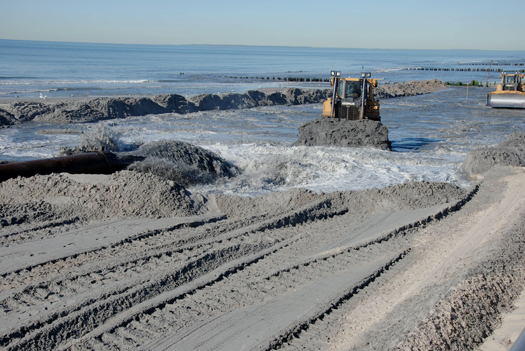
[Beach replenishment on Rockaway Beach, New York (well before Hurricane Sandy); image via USACE]
Fellow Dredge Research Collaborator Brett Milligan and I have a co-authored article in the latest issue of Scenario Journal (formerly Landscape Urbanism Journal), 04: Rethinking Infrastructure. The article reflects on the after effects of Hurricane Sandy, the history and future of Jamaica Bay, and lessons learned at DredgeFest NYC:
“In the wake of the storm, the pivotal role of New York’s sedimentary infrastructures in both enabling commerce within the harbor and serving as bulwarks against and dissipaters of storm surge was highlighted, shedding new light on the urgency of the task of understanding and contending with climate change, coastal resiliency, and the dredge cycle in tandem. A wide variety of responses to the storm have been broached in the press by politicians, designers, engineers, and scientists: multi-billion dollar surge barriers permanently emplaced in the harbor [32]; home buyouts in flood-damaged areas with the intention of retreating from the most heavily impacted zones[33]; “grassy network of land-based parks accompanied by watery patches of wetlands and tidal salt marshes,” as well as “breakwater islands made of geotextile tubes and covered with marine plantings” [34]; strategically hardening infrastructures to better absorb the impact of and ride out flooding when it does occur; and “a system of artificial reefs in the channel and the bay built out of rocks, shells and fuzzy rope that is intended to nurture the growth of oysters,” “nature’s wave attenuators” [35].
If events such as DredgeFest NYC and the conception of the dredge cycle have something unique to offer in this conversation, it is recognizing the quasi-designed linkages between multiple anthropogenically-driven landscape processes, be they dredging itself, beach nourishment, the Panama Canal Expansion, wetlands both eroding and accreting, coastal development, or sea level rise and ever-increasing frequencies of intense storms. Observing and acting upon these networked material relations is at least as critical to the resilience of urban systems as dealing with any individual component in isolation. The salt marshes of Jamaica Bay shrank for a hundred years without any human intervention intended to ameliorate or reverse that shrinkage. Restoration work only began when a seemingly unconnected event in a distant country, the Canal Expansion, produced a sudden surplus of suitable sand, and engineers and scientists opportunistically seized the chance to utilize that surplus. Re-designing the dredge cycle for the Anthropocene will require observing, designing, and manipulating such feedbacks, harnessing their aggregate energy so that they strengthen rather than undermine systemic resiliency.”
You can read the full article at Scenario Journal.
[Speaking of the future of Jamaica Bay: you might want to check out “Protective Ecologies”, a short video produced by several of our DredgeFest collaborators — Gena Wirth, Alex Chohlas-Wood, and Ben Mendelsohn. “Protective Ecologies” was recently included in an exhibition at MoMA’s PS1 VW Dome 2. Speaking of Scenarios Journal 04, there are a number of other fantastic essays in the issue; I’ll probably excerpt a couple of the most intriguing ones over the next few days or weeks.]

